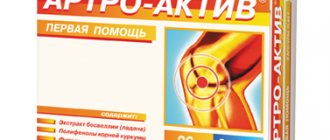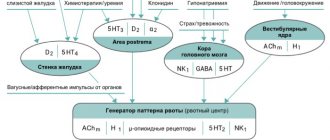pharmachologic effect
Antihypoxic, antiaggregation, neuroprotective, vasodilator, improves cerebral circulation.
Pharmacokinetics
Suction
After oral administration, it is quickly absorbed. Cmax in blood plasma is achieved 1 hour after administration. Absorption occurs mainly in the proximal gastrointestinal tract. When passing through the intestinal wall it is not metabolized. Cmax in tissues is observed 2-4 hours after oral administration. Bioavailability is 7%.
Distribution
With repeated oral doses of 5 mg and 10 mg, the kinetics are linear.
Binds to plasma proteins by 66%. Penetrates through the placental barrier.
Metabolism and excretion
Clearance of 66.7 l/h exceeds the plasma volume of the liver (50 l/h), indicating extrahepatic metabolism.
T1/2 is 4.83±1.29h. Excreted in urine and feces in a ratio of 3:2.
Pharmacodynamics
Improves brain metabolism by increasing the consumption of glucose and oxygen by brain tissue. Increases the resistance of neurons to hypoxia, enhancing the transport of glucose to the brain through the BBB; transfers the process of glucose breakdown to the more energy-efficient aerobic pathway; selectively blocks Ca2+-dependent phosphodiesterase; increases levels of AMP and cGMP in the brain. Increases the concentration of ATP and the ATP/AMP ratio in brain tissue; enhances the exchange of norepinephrine and serotonin in the brain; stimulates the ascending branch of the noradrenergic system and has an antioxidant effect.
Reduces platelet aggregation and increased blood viscosity; increases the deforming ability of red blood cells and blocks the utilization of adenosine by red blood cells; helps increase oxygen delivery by red blood cells. Strengthens the neuroprotective effect of adenosine.
Increases cerebral blood flow; reduces the resistance of cerebral vessels without significant changes in systemic circulation parameters (BP, minute volume, heart rate, peripheral vascular resistance). Not only does it not have a “stealing” effect, but it also increases blood supply, primarily in ischemic areas of the brain with low perfusion.
Chemical composition and dosage forms
The active compound of the drug is vinpocetine. It has a vasodilator (vasodilator), antioxidant, neuroprotective effect, stimulates metabolic processes in tissues, and normalizes the rheological properties of blood.
Cavinton is produced in two pharmaceutical forms:
- Tablets: in blisters, white, with the Cavinton inscription engraved on the surface, the dosage of the active substance is 5 mg. Auxiliary components of the drug: silicon dioxide, talc, magnesium stearate, starch.
- Infusion solution in ampoules of 2 and 5 ml, used intravenously. In addition to vinpocetine, it contains distilled water, ascorbic and tartaric acids, and sorbitol.
Indications for use of Cavinton forte
Neurology: to reduce the severity of neurological and mental symptoms in various forms of cerebral circulatory failure (including conditions after an ischemic stroke, the recovery stage of hemorrhagic stroke, the consequences of a stroke, transient ischemic attack, vascular dementia, vertebrobasilar insufficiency, cerebral atherosclerosis , post-traumatic and hypertensive encephalopathy).
Ophthalmology: chronic vascular diseases of the choroid and retina.
Otorhinolaryngology: for the treatment of perceptual hearing loss, Meniere's disease, idiopathic tinnitus.
To avoid complications, use strictly as prescribed by your doctor.
Instructions for use of CAVINTON®
Distribution
With repeated oral administration in doses of 5 mg and 10 mg, the kinetics are linear, Css are 1.2±0.27 ng/ml and 2.1±0.33 ng/ml, respectively. Absolute bioavailability when taken orally is about 7%.
Plasma protein binding in humans is 66%. Vd is 246.7±88.5 l, which indicates good distribution in tissues.
Studies with radiolabeled vinpocetine have shown that when the drug is administered orally to rats, the greatest radioactivity is observed in the liver and gastrointestinal tract. Cmax in tissues is observed 2-4 hours after oral administration. The concentration of the radioactive tracer in the brain tissue did not exceed the concentration in the blood.
Metabolism
The main metabolite of the main metabolite is apovincamic acid (VKA), the amount of which in humans is 25-30%. Clearance is 66.7 l/h and exceeds hepatic clearance (50 l/h), indicating extrahepatic metabolism of vinpocetine.
Compared with intravenous administration, the AUC of VKA after taking the drug orally is 2 times greater, which indicates the formation of VKA in the process of first-pass metabolism of vinpocetine. Other metabolites of vinpocetine:
- hydroxyvinpocetine, hydroxy-AVK, dihydroxy-AVK-glycinate and their conjugates with glucuronides and/or sulfates. The amount of vinpocetine that is excreted unchanged is several percent of the dose taken.
Removal
T1/2 in humans is 4.83±1.29 hours.
In studies using radiolabeled vinpocetine, excretion was found to be primarily renal (60%) and intestinal (40%). A larger amount of radioactive tracer in rats and dogs was found in the bile, but no significant intrahepatic circulation was observed.
VKA is excreted mainly by the kidneys through glomerular filtration, T1/2 depends on the dose and frequency of taking the drug.
Pharmacokinetics in special clinical situations
Since vinpocetine is indicated for the treatment of predominantly elderly patients who experience changes in drug kinetics - decreased absorption, different distribution and metabolism, decreased excretion - studies of the pharmacokinetics of vinpocetine were carried out in this group, especially with long-term use. The results of such studies have demonstrated that the kinetics of vinpocetine in elderly people does not differ significantly from the kinetics of vinpocetine in young people and, in addition, there is no accumulation.
An important and significant property of vinpocetine is that there is no need for special selection of the drug dose in patients with liver or kidney diseases due to the metabolism of the drug and the absence of cumulation (accumulation).
Use during pregnancy and children
Cavinton® Forte is contraindicated for use during pregnancy, because Vinpocetine penetrates the placental barrier. Moreover, its concentration in the placenta and in the blood of the fetus is lower than in the blood of a pregnant woman. When taken in high doses, placental bleeding and spontaneous abortion may develop, probably as a result of increased placental blood supply.
Within 1 hour, 0.25% of the administered dose of the drug is excreted in breast milk. If it is necessary to use the drug during lactation, breastfeeding should be stopped.
How Cavinton works
The instructions for use of the drug inform that vinpocetine belongs to the category of cerebrovasodilating substances. It stimulates metabolism and nutrition of the brain, prevents the development of atherosclerotic lesions, improves the absorption of glucose and oxygen by cells. Cavinton helps improve the functioning of the adrenal glands, helps the exchange of norepinephrine, serotonin and other hormones.
The drug works selectively. Affects cerebral blood volume, reduces resistance of the cerebral vasculature. This process helps restore circulation in tissue areas exposed to ischemia. At the same time, the activity of the general blood circulation does not change. Heart rate and blood pressure levels remain the same after taking the medicine. The so-called reverse steal effect ensures that the affected areas remain viable. Cavinton:
- normalizes blood viscosity;
- reduces excessive platelet aggregation;
- increases cell resistance to hypoxic effects;
- slows down the penetration of adenosine into red blood cells, making them more elastic and preventing breakdown.
The drug tablets quickly dissolve in the stomach and are absorbed into the blood. The effect of the substance reaches its maximum within 1–1.5 hours. The effectiveness of injections is slightly higher. The drug does not accumulate in the body. It is excreted completely, without forming metabolites, along with feces and urine within 24 hours after administration.
Side effects
Side effects associated with the use of the drug were rarely detected.
From the cardiovascular system: ECG changes (ST depression, prolongation of the QT interval); tachycardia, extrasystole (however, the presence of a causal relationship has not been proven, since in the natural population these symptoms are observed with the same frequency); lability of blood pressure, feeling of hot flashes.
From the central nervous system: sleep disturbances (insomnia, increased drowsiness), dizziness, headache, general weakness (these symptoms may be manifestations of the underlying disease).
From the digestive system: dry mouth, nausea, heartburn.
Other: allergic skin reactions, increased sweating.
Cavinton®
Suction
Vinpocetine is rapidly absorbed after oral administration and reaches its maximum blood concentration (Cmax) within 1 hour. Absorption occurs mainly in the proximal intestine. It is not metabolized when passing through the intestinal wall.
Distribution
In preclinical studies of oral administration of radiolabeled vinpocetine, it was detected in the highest concentrations in the liver and gastrointestinal tract.
The maximum concentration in tissues is observed 2-4 hours after ingestion. The amount of radioactive isotope in the brain did not exceed that in the blood. Connection with proteins in the human body - 66%. The volume of distribution is 246.7 ± 88.5 L, indicating significant tissue binding. Bioavailability when taken orally - 7%. Clearance is 66.7%, which exceeds the plasma volume of the liver (50 l/h), metabolism is predominantly extrahepatic.
Metabolism
The main metabolite of vinpocetine is apovincamic acid (AVA), the proportion of which in humans is 25-30%. After oral administration of vinpocetine, the area under the concentration-time curve of VKA is 2 times greater than that after intravenous administration. This indicates that VKA is formed during the first pass metabolism of vinpocetine. Other known metabolites are hydroxyvinpocetine, hydroxy-AVA, dihydroxy-AVA-glycinate, and their conjugates with glucuronides and/or sulfates. Preclinical studies revealed that vinpocetine is excreted unchanged in small quantities.
For liver and kidney diseases, no dose adjustment is required due to the peculiarity of the metabolism of vinpocetine - the absence of cumulation.
Removal
With repeated doses of 5 and 10 mg, the kinetics of vinpocetine is linear. Steady-state concentrations were 1.2 ± 0.27 ng/ml and 2.1 ± 0.33 ng/ml, respectively. The half-life in humans is 4.83 ± 1.29 hours. In studies with a radioactive label, the drug was excreted by the kidneys and through the intestines in a ratio of 60:40. In preclinical studies, a significant portion of the radioactivity was detected in bile, but significant enterohepatic circulation was not found. Apovinamic acid is excreted by the kidneys by simple glomerular filtration; the half-life depends on the dose taken and the route of administration of vinpocetine.
Pharmacokinetics in certain groups of patients (age, concomitant diseases)
It was revealed that the pharmacokinetics of vinpocetine in elderly patients does not differ significantly from that in young patients; there is no accumulation of the drug. Therefore, vinpocetine can be prescribed to patients with impaired liver and kidney function for a long time and in normal doses.
Drug interactions
No interaction is observed when used simultaneously with beta-blockers (chloranolol, pindolol), clopamide, glibenclamide, digoxin, acenocoumarol and hydrochlorothiazide, imipramine.
The simultaneous use of Cavinton® Forte and methyldopa sometimes caused a slight increase in the hypotensive effect, therefore, when using this combination, regular blood pressure monitoring is required.
Despite the lack of data confirming the possibility of interaction, it is recommended to exercise caution when prescribing Cavinton Forte simultaneously with centrally acting drugs, antiarrhythmics and anticoagulants.
When is Cavinton contraindicated?
Contraindications include:
- children's age: up to 18 years, the vascular system is imperfect;
- during pregnancy and lactation: due to the insufficiently studied effect of the drug on the body of the fetus and newborns;
- lactose intolerance;
- severe heart damage accompanied by arrhythmia;
- hypersensitivity to the components of the drug.
Cavinton is prohibited from being used in conjunction with heparin preparations due to the risk of a sharp decrease in blood clotting. Simultaneous intake of alcohol is also prohibited, since the active substance enhances its toxic properties.
Cavinton forte dosage
The duration of treatment and dose are determined by the doctor.
Inside, after eating.
Typically the daily dose is 15-30 mg (5-10 mg 3 times a day). The initial daily dose is 15 mg. The maximum daily dose is 30 mg.
The therapeutic effect develops approximately a week from the start of taking the drug. It takes 3 months to achieve the full therapeutic effect.
For diseases of the kidneys and liver, no adjustment of the dosage regimen is required; the absence of accumulation allows for long courses of treatment.
How to use Cavinton correctly: instructions
The medication is approved for patients over 18 years of age. Treatment with the drug in tablets requires long-term administration. The full course ranges from 1 to 8 months, depending on the type of disease. On average, to achieve pronounced results, Cavinton is taken for 3–4 months in a row:
- 1 tab. three times a day, without chewing;
- You need to take the medicine with a large volume of water;
- time of administration: 1–1.5 hours after meals.
The infusion drug must be administered intravenously: through a syringe or through droppers. Intramuscular use of the product is prohibited.
- Before use, Cavinton is diluted in saline solution at the rate of: 20 ml of concentrate per 500 ml of liquid;
- the prepared solution is suitable for use within 3 hours;
- therapy is carried out by administering 80 drops of the drug per minute.
The exact treatment regimen is formed by the doctor, taking into account the indications and general condition of the patient’s body. Cavinton should be discontinued gradually, gradually reducing the dosage over 3–5 days.
The medicine does not have a toxic effect on the kidneys and liver. It should be used with caution in case of hemorrhagic stroke: no earlier than 7 days after the attack.



